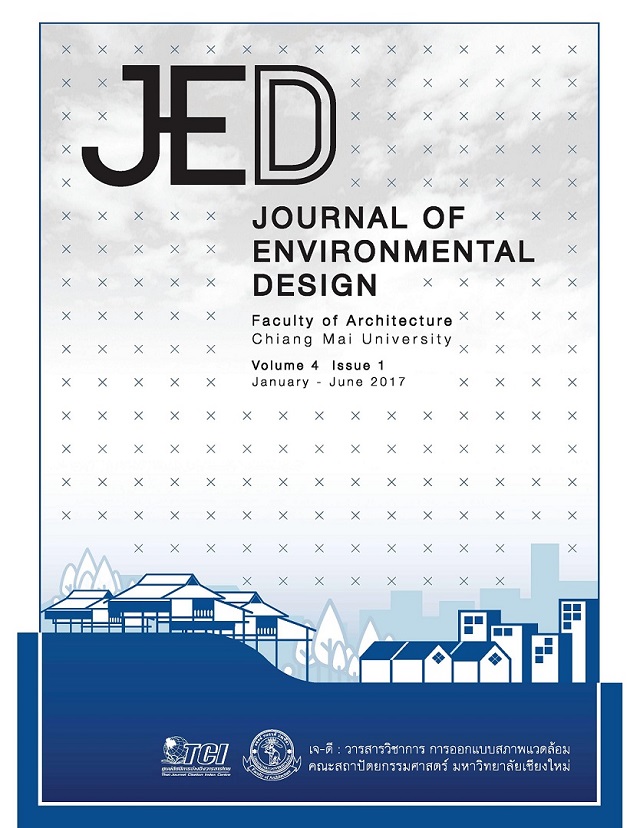เรือนแถวและตึกแถวในภูมิทัศน์ย่านประวัติศาสตร์พิมาย (Row houses and buildings in Phimai historic urban landscape)
Main Article Content
บทคัดย่อ
เรือนแถวและตึกแถวในภูมิทัศน์ย่านประวัติศาสตร์ของตัวเมืองพิมาย ตั้งอยู่ในเขตเมืองเก่าในเขตกำแพงเมืองชั้นในของเมืองพิมาย ทำเลดังกล่าวทำหน้าที่เป็นย่านการค้ามาตั้งแต่สมัยทวารวดี ซึ่งปรากฏหลักฐานเป็นอโรคยาศาล เป็นที่พักของนักเดินทางที่ใช้ติดต่อค้าขายระหว่างเมืองพระนครและเมืองแถบลุ่มน้ำเจ้าพระยา ส่งผลให้พิมายมีความเจริญรุ่งเรืองทางศาสนา สถาปัตยกรรม และเศรษฐกิจของเมืองโดยปรากฏหลักฐานเป็นปราสาทหินพิมายที่คงอยู่จนถึงปัจจุบัน ช่วงรัตนโกสินทร์ย่านการค้าพิมายนั้น เจริญด้วยภูมิประเทศที่เหมาะสมอยู่ใกล้ลำน้ำมูล ซึ่งเป็นเส้นทางค้าขายสินค้าทางเรือระหว่างภาคอีสานไปยังกรุงเทพฯ จึงส่งผลให้เมืองพิมายเป็นเมืองที่มีเศรษฐกิจการค้าที่เจริญรุ่งเรือง และย่านการค้าของเมืองพิมายนี้ ยังทำหน้าที่เรื่อยมาจนมีการปลูกสร้างอาคารแถวเพื่อทำหน้าที่เป็นที่อยู่อาศัยและค้าขาย โดยในระยะแรกเท่าที่ปรากฏหลักฐานนั้นเป็นอาคารปลูกสร้างด้วยไม้ ในที่นี้จึงเรียก “เรือนแถวไม้พื้นถิ่น” ต่อมามีการสร้าง “ตึกแถวพื้นถิ่น” ที่มีลักษณะเป็นอาคารก่ออิฐ โดยการก่ออิฐขึ้นรูปอาคาร โดยมีความสัมพันธ์กับบริบทแวดล้อมทางสังคมและเศรษฐกิจอย่างใกล้ชิด ผลกระทบจากการสร้างรถไฟสายกรุงเทพ-นครราชสีมาเมื่อ พ.ศ.2443ได้นำมาซึ่งวัสดุจำพวกเหล็ก สังกะสี ส่งผลให้มีการนำวัสดุสมัยใหม่เข้ามาใช้ร่วมกันกับเรือนแถวไม้ และในช่วง พ.ศ.2500 กรมศิลปากรได้ทำการบูรณะปราสาทหินพิมาย ซึ่งส่งผลให้เกิดการเปลี่ยนแปลงผังเมืองพิมาย เนื่องจากมีการย้ายตลาดสดและที่ว่าการอำเภอออกจากบริเวณเดิมเพื่อทำการบูรณะปราสาทหินพิมาย และมีการตัดถนนจากนครราชสีมาเข้าสู่ตัวเมืองพิมาย ทำให้การคมนาคมทางน้ำได้ลดบทบาทลงและพร้อมกับการเข้ามาของวัสดุจำพวกปูนซีเมนต์ที่มีให้ใช้มากขึ้น ซึ่งในช่วงเวลาเดียวกันนี้มีความนิยมในการก่อสร้างอาคารแถวรูปแบบใหม่ที่เรียกว่า “ตึกแถวสมัยใหม่ระยะต้น” ที่แสดงนัยยะของความทันสมัยตามแนวคิดของจอมพล ป.พิบูลสงคราม ซึ่งยังคงส่งผลถึงรูปแบบตึกแถวในปัจจุบัน
Row house and buildings in the historic urban landscape of Phimai, the historic district, are located in the old town in the inner walls of Phimai. It had been a central commercial district since Dvaravati period. The evidence is a pavilion where the traders used to rest when they traded between cities: the capital city and the Chao Phraya River basin area. This had promoted the religious, architectural, and economic prosperity; the evidence is the Phimai sanctuary that is still at that place. During the period, the commercial district, Phimai, had grown into a prosperous district as it is located near the Mun River, a trade route between the Northeast of Thailand to Bangkok. Moreover, as Phimai district continued its prosperity, the shophouses were also built to be both residential spaces (mostly on the top floor) and shops (down stair). In the beginning, according to the evidence provided, the buildings were built with wood called “wooden vernacular shophouses.” After that “vernacular shophouses” were built; they used bricks in building them, which shows the impact of social and economic context on the houses. Especially, the Bangkok - Nakhon Ratchasima railway line that opened to traffic in 1900, which brought materials such as metal and galvanized iron to community, influenced people to combine modern materials with the wooden shophouses. Moreover, in 1957, the Fine Arts Department had restored Phimai, which caused the change in urban planning. Because of the restoration of Phimai and the opening of the new road connecting Nakorn Rachasrima with Phimai city, the market and the district office had to be moved. In consequence, the water transportation had declined and cement type of materials had become well-known and being used. At that time, “early modern shophouses” had become popular showing the modern concept of Chom Phon. PS. Phibulsongkram and this type of shophouses has been influencing shophouses from then until now.


